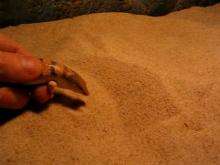Scincus scincus
| Sandfish | |
|---|---|
 | |
| Scientific classification | |
| Kingdom: | Animalia |
| Phylum: | Chordata |
| Class: | Reptilia |
| Order: | Squamata |
| Family: | Scincidae |
| Genus: | Scincus |
| Species: | S. scincus |
| Binomial name | |
| Scincus scincus (Linnaeus, 1758) | |
The sandfish (Scincus scincus) is a species of skink that burrows into the sand and swims[1] through it. It is native to north Africa and southwestern Asia, but is also kept as a pet elsewhere.[2]
Description
The name sandfish originated because of its ability to move through sand as if it were swimming. Adult sandfish usually reach about 8 inches (20 cm) in length, including the short tail.
The sandfish has developed a peculiar way of dealing with the desert heat: it can dive into soft sand. It does this to prevent overheating (as it is cold-blooded) and whenever it feels threatened.
This skink has a long, wedge-shaped snout with a countersunk lower jaw. Its long, tapered body is covered with smooth, shiny scales, and its legs are short and sturdy with long, flattened and fringed feet. The tail is short, tapering to a fine point. The colouration of this species is considered attractive, being yellow-caramel with brown-black cross bands. This lizard also has bead-like eyes so it can close them to keep sand out of its eyes. Similarly, its nostrils are very small to keep all of the sand out of its nose and lungs.
X-ray imaging[3] has demonstrated the lizard swims within sand using an undulatory gait with its limbs tucked against its sides rather than use its limbs as paddles [4] to propel itself forward. Subsequent studies of the mathematics of sandfish sand-swimming,[5] using robotic models,[6] and electromyography[7] show that the sandfish uses the optimum waveform to move through the sand with minimal energetic cost, given its anatomy.
Range

Species in the Scincus genus are distributed over an extensive belt of desert from the west coast of Africa, through the Sahara and into Arabia. [8]
Diet
The sandfish is an insectivore. It can detect vibrations the insects in its vicinity create while moving.
Captivity
These small reptiles are common among the US and UK pet stores. It is very simple to care for, but rarely breeds in captivity, so most animals in pet trade are wild-caught.
References
- ↑ Fountain, Henry (2009-07-21). "A Saharan Lizard Is a Sand Swimmer". The New York Times. Retrieved 2010-05-23.
- ↑ http://science.jrank.org/pages/5956/Sandfish.html
- ↑ Maladen, R. D.; Ding, Y.; Li, C.; Goldman, D. I. (2009). "Undulatory Swimming in Sand: Subsurface Locomotion of the Sandfish Lizard" (PDF). Science. 325 (5938): 314–318. doi:10.1126/science.1172490.
- ↑ Baumgartner, Werner; Fidler, Florian; Weth, Agnes; Habbecke, Martin; Jakob, Peter; Butenweg, Christoph; Böhme, Wolfgang (2008). "Investigating the Locomotion of the Sandfish in Desert Sand Using NMR-Imaging". PLoS ONE. 3 (10): e3309. doi:10.1371/journal.pone.0003309. PMC 2561000
 . PMID 18836551.
. PMID 18836551. - ↑ Ding, Yang; Sharpe, Sarah S.; Masse, Andrew; Goldman, Daniel I. (2012). "Mechanics of Undulatory Swimming in a Frictional Fluid". PLoS Computational Biology. 8 (12): e1002810. doi:10.1371/journal.pcbi.1002810.
- ↑ Maladen, R. D.; Ding, Y.; Umbanhowar, P. B.; Kamor, A.; Goldman, D. I. (2011). "Mechanical models of sandfish locomotion reveal principles of high performance subsurface sand-swimming". Journal of The Royal Society Interface. 8 (62): 1332–1345. doi:10.1098/rsif.2010.0678.
- ↑ Sharpe, S. S.; Ding, Y.; Goldman, D. I. (2012). "Environmental interaction influences muscle activation strategy during sand-swimming in the sandfish lizard Scincus scincus". Journal of Experimental Biology. 216 (2): 260–274. doi:10.1242/jeb.070482.
- ↑ Baumgartner, W., Fidler, F., Weth, A., Habbecke, M., Jakob, P., Butenweg, C. and Böhme, W. (2008) Investigating the Locomotion of the Sandfish in Desert Sand Using NMR-Imaging. PLoS ONE, 3(10).
Baumgartner, W., Fidler, F., Weth, A., Habbecke, M., Jakob, P., Butenweg, C. and Böhme, W. (2008) Investigating the Locomotion of the Sandfish in Desert Sand Using NMR-Imaging. PLoS ONE, 3(10).
Further reading
- Friction reduction in Sandfish (in German)
External links
| Wikimedia Commons has media related to Scincus scincus. |
- physorg.com Study Reveals Small Lizard Tucks Legs and Swims Like a Snake Through Desert Sand (w/ Video)
- Movies on sandfish locomotion